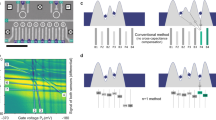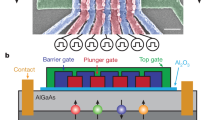Abstract
Controlling long-distance quantum correlations is central to quantum computation and simulation. In quantum dot arrays, experiments so far rely on nearest-neighbour couplings only, and inducing long-distance correlations requires sequential local operations. Here, we show that two distant sites can be tunnel-coupled directly. The coupling is mediated by virtual occupation of an intermediate site, with a strength that is controlled via the energy detuning of this site. It permits a single charge to oscillate coherently between the outer sites of a triple dot array without passing through the middle, as demonstrated through the observation of Landau–Zener–Stückelberg interference. The long-distance coupling significantly improves the prospects of fault-tolerant quantum computation using quantum dot arrays, and opens up new avenues for performing quantum simulations in nanoscale devices.
This is a preview of subscription content, access via your institution
Access options
Subscribe to this journal
Receive 12 print issues and online access
$259.00 per year
only $21.58 per issue
Buy this article
- Purchase on Springer Link
- Instant access to full article PDF
Prices may be subject to local taxes which are calculated during checkout





Similar content being viewed by others
References
Loss, D. & DiVincenzo, D. P. Quantum computation with quantum dots. Phys. Rev. A 47, 120–126 (1998).
Taylor, J. M. et al. Fault-tolerant architecture for quantum computation using electrically controlled semiconductor spins. Nature Phys. 1, 177–183 (2005).
Hanson, R., Kouwenhoven, L. P., Petta, J. R., Tarucha, S. & Vandersypen, L. M. K. Spins in few-electron quantum dots. Rev. Mod. Phys. 79, 1217–1265 (2007).
Hayashi, T., Fujisawa, T., Cheong, H. D., Jeong, Y. H. & Hirayama, Y. Coherent manipulation of electronic states in a double quantum dot. Phys. Rev. Lett. 91, 226804 (2003).
Oosterkamp, T. H. et al. Microwave spectroscopy of a quantum-dot molecule. Nature 395, 873–876 (1998).
Petta, J. R., Johnson, A. C., Marcus, C. M., Hanson, M. P. & Gossard, A. C. Manipulation of a single charge in a double quantum dot. Phys. Rev. Lett. 93, 186802 (2004).
Petta, J. R. et al. Coherent manipulation of coupled electron spins in semiconductor quantum dots. Science 309, 2180–2184 (2005).
Nowack, K. C. et al. Single-shot correlations and two-qubit gate of solid-state spins. Science 333, 1269–1272 (2011).
Fowler, A. G., Stephens, A. M. & Groszkowski, P. High-threshold universal quantum computation on the surface code. Phys. Rev. A 80, 052312 (2009).
Stephens, A. M. & Evans, Z. W. E. Accuracy threshold for concatenated error detection in one dimension. Phys. Rev. A 80, 022313 (2009).
Kim, K. et al. Quantum simulation of frustrated Ising spins with trapped ions. Nature 465, 590–593 (2010).
Recher, P., Loss, D. & Levy, J. in Macroscopic Quantum Coherence and Quantum Computing 293–306 (Kluwer Academic, 2001).
Mattis, D. C. The Theory of Magnetism made Simple (World Scientific, 2006).
Schmidt-Kaler, F. et al. Realization of the Cirac–Zoller controlled-NOT quantum gate. Nature 422, 408–411 (2003).
Majer, J. et al. Coupling superconducting qubits via a cavity bus. Nature 449, 443–447 (2007).
Sillanpää, M. A., Park, J. I. & Simmonds, R. W. Coherent quantum state storage and transfer between two phase qubits via a resonant cavity. Nature 449, 438–442 (2007).
Imamoglu, A. et al. Quantum information processing using quantum dot spins and cavity QED. Phys. Rev. Lett. 83, 4204–4207 (1999).
Taylor, J. M. & Lukin, M. D. Cavity quantum electrodynamics with semiconductor double-dot molecules on a chip. Preprint at http://arxiv.org/abs/cond-mat/0605144v1 (2006).
Burkard, G. et al. & Imamoglu, A. Ultra-long-distance interaction between spin qubits. Phys. Rev. B 74, 041307(R) (2006).
Trif, M., Golovach, V. N. & Loss, D. Spin dynamics in InAs nanowire quantum dots coupled to a transmission line. Phys. Rev. B 77, 045434 (2008).
Frey, T. et al. Dipole coupling of a double quantum dot to a microwave resonator. Phys. Rev. Lett. 108, 046807 (2012).
Petersson, K. D. et al. Circuit quantum electrodynamics with a spin qubit. Nature 490, 380–383 (2012).
Hermelin, S. et al. Electrons surfing on a sound wave as a platform for quantum optics with flying electrons. Nature 477, 435–438 (2011).
Mcneil, R. P. G. et al. On-demand single-electron transfer between distant quantum dots. Nature 477, 439–442 (2011).
Trauzettel, B., Bulaev, D. V., Loss, D. & Burkard, G. Spin qubits in graphene quantum dots. Nature Phys. 3, 192–196 (2007).
Ihn, T. Semiconductor Nanostructures: Quantum states and Electronic Transport (Oxford Univ. Press, 2010).
Reilly, D. J., Marcus, C. M., Hanson, M. P. & Gossard, A. C. Fast single-charge sensing with a rf quantum point contact. Appl. Phys. Lett. 91, 162101 (2007).
Busl, M. et al. Bipolar spin blockade and coherent state superpositions in a triple quantum dot. Nature Nanotech. 8, 261–265 (2013).
Gustavsson, S. et al. Electron counting in quantum dots. Surf. Sci. Rep. 64, 191–232 (2009).
Van der Wiel, W. G. et al. Electron transport through double quantum dots. Rev. Mod. Phys. 75, 1–22 (2003).
Shevchenko, S. N., Ashhab, S. & Nori, F. Landau–Zener–Stückelberg interferometry. Phys. Rep. 492, 1–30 (2010).
Child, M. S. Molecular Collision Theory (Dover Publications, 1974).
Nikitin, E. E. & Umanski, S. Y. Theory of Slow Atomic Collisions (Springer, 1984).
Oliver, W. D. et al. Mach–Zehnder interferometry in a strongly driven superconducting qubit. Science 310, 1653–1657 (2005).
Petta, J. R., Lu, H. & Gossard, A. C. A coherent beam splitter for electronic spin states. Science 327, 669–672 (2010).
Pioro-Ladrière, M. et al. Origin of switching noise in GaAs/AlxGa1–xAs lateral gated devices. Phys. Rev. B 72, 115331 (2005).
Acknowledgements
The authors acknowledge discussions with T. Baart, R. Hanson, E. Kawakami, L. Kouwenhoven, Y. Nazarov, G. Platero, P. Scarlino and M. Shafiei, and thank A. van der Enden, J. Haanstra, R. Roeleveld and R. Schouten for technical support. This work is supported by the Stichting voor Fundamenteel Onderzoek der Materie (FOM), The Netherlands Organization for Scientific Research (NWO), the Office of the Director of National Intelligence, Intelligence Advanced Research Projects Activity (IARPA), through the US Army Research Office (grant W911NF-12-1-0354), the European Office of Aerospace Research and Development (EOARD) and the Swiss National Science Foundation.
Author information
Authors and Affiliations
Contributions
F.R.B. performed the experiment. C.R. and W.W. grew the heterostructure. F.R.B. fabricated the sample. F.R.B. and P.B. carried out the data analysis. F.R.B., P.B and L.M.K.V. contributed to interpretation of the data and commented on the manuscript. F.R.B. and L.M.K.V. wrote the manuscript.
Corresponding author
Ethics declarations
Competing interests
The authors declare no competing financial interests.
Supplementary information
Supplementary information
Supplementary information (PDF 935 kb)
Rights and permissions
About this article
Cite this article
Braakman, F., Barthelemy, P., Reichl, C. et al. Long-distance coherent coupling in a quantum dot array. Nature Nanotech 8, 432–437 (2013). https://doi.org/10.1038/nnano.2013.67
Received:
Accepted:
Published:
Issue Date:
DOI: https://doi.org/10.1038/nnano.2013.67
This article is cited by
-
Loading a quantum-dot based “Qubyte” register
npj Quantum Information (2019)
-
Single hole spin relaxation probed by fast single-shot latched charge sensing
Communications Physics (2019)
-
Coherent spin-exchange via a quantum mediator
Nature Nanotechnology (2017)
-
Silicon CMOS architecture for a spin-based quantum computer
Nature Communications (2017)
-
Detection and control of charge states in a quintuple quantum dot
Scientific Reports (2016)



